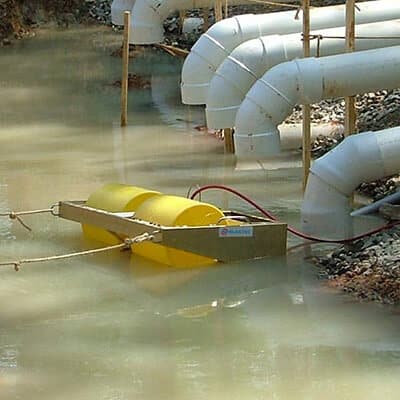What Fouls YourService Water Environment?
Litter, logs, leaves, frazil ice, fish, jellyfish, vegetation, clams and mussels, silt, mud, seaweed and algae can block cooling water intakes and reduce or completely disable hydroelectric plants, paper mills, chemical manufacturers, petroleum refineries and other industrial facilities. Blockages, as well as oil leaks, can occur in all types of service water environments.
Protection from obstructions and oil spills requires vigilant inspections and preventative measures to avoid plant shutdowns while simultaneously safeguarding the aquatic eco-system.
For 50 years, American Marine (a division of Elastec) has been making floating barriers and turbidity curtains to control trash, natural debris, silt, aquatic weeds and invasive marine species from clogging up intake filters – as well as to control silt during marine construction projects. In fact, American Marine invented the first turbidity curtain.
Teamed with Elastec’s 25 years of manufacturing oil spill recovery equipment: skimmers, oil boom, work boats, vacuum systems and portable incinerators – we provide a variety of products and design assistance to protect your service water intake environment.


Invasion of the Jellyfish
PermaFence/NetBoom Keeps the Jellies from Jamming Intake in Saudi Arabia
Jellyfish form a gelatinous wall blocking the cooling water intake system which interferes with the condensation of steam. Cities around the world could be without electricity unless something is done. Fact or fiction?
It’s a FACT! Jellyfish jammed an intake in Saudi Arabia decreasing electrical power.
Fortunately, Elastec had a solution: PermaFence/NetBoom.

PermaFence/NetBoom is an effective, easy-to-deploy solution to block jellyfish from jamming the water intake filters of power plants. The PermaFence/Netboom can also keep debris and invasive aquatic plants at bay. This heavy-duty system is designed for permanent installations and requires minimal maintenance. Constructed with specially-molded, foam-filled floats surrounded by ultraviolet- and abrasion-resistant high-density polyethylene, this durable and secure system performs exceptionally well in conditions of high salinity and extreme heat.

The typical opening size of the netting is 1” x 1”. Nets can be custom-made for specific situations altering the size, depth and strength, ranging from light to deeply robust situations. And when the jellyfish jam the PermaFence/NetBoom, simply pull the fence from the water, pressure wash and replace.
PermaFence/NetBoom can also be used for controlling trash at outfalls, debris at construction sites and waste control in stormwater canals.
Nuclear Power Plant Employees React to the Omni Catamaran
A nuclear power plant was looking for a simple boat to skim trash and debris away from the cooling water intake. Hear employee’s reaction upon seeing the Omni Catamaran skimming litter for the first time.
Texas Trash
Brute Boom Captures Trash from San Antonio River Tributary
The San Antonio River Authority has a staff dedicated just to picking up trash after a major storm. Between rains, litter and debris collect in streets and along river banks. After the “first flush” of a rainstorm, trash flows into the river and the crew spends hours walking along the river banks picking up trash. The Elastec Brute Boom is hoping to capture it to make the collection easier.

Dam Oil Leak
Skim It with Elastec Oil Skimmers
Hydroelectric power generation plants can have oil leaks from turbines, gears and traveling fish screen motors. If not recovered, the oil can drift into sumps or cooling water environments. Elastec’s oil skimmers can recover all types of oil – from diesel to heavier hydrocarbons – before water is discharged into the neighboring river.
Nothing Gets Past the Beach Bouncer!
Protect Intakes from Invasive Aquatic Weeds
Sargassum, a brown, stinky seaweed, was invading resorts and private beaches in the Caribbean, Mexico and Florida. This floating aquatic plant, also known as gulfweed or sea holly, drifted up from the Sargasso Sea in ocean currents and became a nightmare for the tourism industry – as well as for sea turtles trying to reach the beach to nest.

